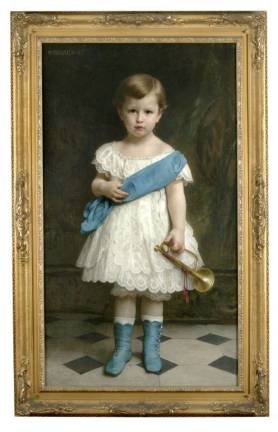High Society

Painting New York's "fashionable world" all those years ago
It's the Gilded Age, that period spanning the end of the Civil War and the beginning of World War I. America is flying high on a rapid industrial expansion and the vast fortunes it spawned. The one percent have decided to have their portraits done, with American painters vying with their European counterparts for a chance to capture the likenesses of the Astors, the Schuylers, the Dyckmans and the Lewisohns. It's the Downton Abbey set with an American twist-and lots of new money.
For just a few more days, the New-York Historical Society is playing host to Beauty's Legacy: Gilded Age Portraits in America, a dazzling exhibit of 65 paintings culled from its immense collection of art, artifacts and memorabilia documenting the life of the city. The Society notably boasts the oldest public art collection in New York.
The subjects here are fittingly New York-centric because that's where scads of business and industry titans made or settled with their money, and the city was home to a sizable social and cultural elite.
This exhibit is best characterized as New York society on parade-old money and the newly minted industrial kind-with a special hat-tip to Mrs. Astor's "Four Hundred," society's upper register. Social arbiter Samuel Ward McAllister, whose 1877 portrait by French painter Adolphe Yvon is included in the show, coined the term, memorably stating that there were "only about 400 people in New York society."
Beauty's Legacy may be a tale of just one city. But it celebrates attributes beyond wealth and social prominence-namely beauty and talent, both as they apply to the sitters and to the artists and the works themselves. The exhibit has as much to do with showing off the sitters' philanthropic works and contributions to New York's civic institutions and growth, as it does with showing off their gowns from the House of Worth (a Parisian design house patronized by wealthy Americans).
Greatest hits from this superb show include works by John Singer Sargent (Mrs. Jacob Wendell, 1888) and lesser-known American portraitists such as George Peter Alexander Healy (Emma Cecilia Thursby, 1879), Daniel Huntington (Mary Gardiner Thompson, 1898), and James Montgomery Flagg (Nellie McCormick Flagg, ca. 1906). Flagg famously painted Uncle Sam on the World War I "I Want YOU!" recruitment poster.
The main gallery room kicks off with American artist James Carroll Beckwith's austere, 1907 portrait of Brooklyn-born Samuel Verplanck Hoffman, a seventh-generation New Yorker and successful businessman-scholar who was president of the New-York Historical Society from 1903 to 1912 and later a member of its executive committee.
Hoffman faces off in the distance with two towering canvases by Frenchman Carolus-Duran-one of silver-and-copper-mining magnate Leonard Lewisohn (1899), the other of his wife Mrs. Leonard Lewisohn (1901), the former Rosalie Jacobs who came from a New York banking family and devoted herself to domestic and charitable causes.
Carolus-Duran, who taught John Singer Sargent and was one of the most highly regarded of the European artists angling for American patronage, had a conservative style that suited the couple. The Lewisohns counted themselves members of the "One Hundred," an elite society of German-Jewish families in the city.
As Guest Curator Barbara Dayer Gallati writes in the show's richly illustrated catalogue, Carolus-Duran's simple, tasteful approach probably won him the prestigious commission, "inasmuch as a solid decorousness formed the foundation of upper-class German-Jewish society, in contrast to the showiness associated with their gentile counterparts."
When Leonard Lewisohn died in 1902, his daughters Irene and Alice used proceeds from his estate to establish The Neighborhood Playhouse (now The Neighborhood Playhouse School of the Theatre on East 54th Street); Irene co-founded the Museum of Costume Art, which merged with The Metropolitan Museum to become its renowned Costume Institute.
Don't miss Peter Marié's exquisite Gallery of Beauty, a collection of mini-portraits in a separate case that stands in sharp contrast to the colossal main attractions. Marié, a society dandy who made his money in shipping, went on a collecting binge after retiring and commissioned miniature watercolor-on-ivory portraits of "Gotham's most beautiful matrons and maidens"-first from French artist Fernand Paillet and later from New York artists such as Carl Weidner.
But lest you get the wrong impression, Gallati writes in the catalogue: "The Platonic veneration of feminine loveliness is key to understanding Marié's collecting passion?[H]e represented a modern version of the chivalrous courtier, whose love for women was in the abstract and never consummated."
In a show replete with such fascinating historical detail, one factoid rises to the top: Mrs. Jacob Wendell had a granddaughter who married the 6th Earl of Carnarvon and became mistress of Highclere Castle-that's right, the real-life Downton Abbey.
Beauty's Legacy: Gilded Age Portraits in America at the New-York Historical Society, 170 Central Park West, New York, NY (now through March 9, 2014)